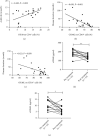Clinical Significance of OX40 and OX40 Ligand in the Peripheral Blood of Patients with Myasthenia Gravis
- PMID: 35265719
- PMCID: PMC8901326
- DOI: 10.1155/2022/4337399
Clinical Significance of OX40 and OX40 Ligand in the Peripheral Blood of Patients with Myasthenia Gravis
Abstract
Background: A previous study on thymomas in myasthenia gravis (MG) patients indicated that OX40 expression may be upregulated in thymic tissues adjacent to germinal centers (GCs) and thymomas, and OX40 may interact with OX40L in GCs to enhance anti-acetylcholine receptor antibody production. However, little is known about the clinical significance of the expression of OX40 and OX40L in the peripheral blood of patients with MG. We aimed to characterize the expression of membrane-bound and soluble OX40 and OX40L in the peripheral blood of patients with MG and to identify their clinical significance.
Methods: For membrane molecules, we collected peripheral blood (PB) from 39 MG patients at baseline, 22 patients in relapse, and 42 patients in remission, as well as from 36 healthy participants as controls. For soluble molecules, plasma from 37 MG patients at baseline, 34 patients in relapse, and 30 patients in remission, as well as plasma from 36 healthy controls (HC), was retrospectively collected from the sample bank of the First Hospital of Soochow University. The expression of membrane-bound OX40 and OX40L (mOX40 and mOX40L) by immune cells was measured using flow cytometry. Plasma levels of soluble OX40 and OX40L (sOX40 and sOX40L) were measured by ELISA.
Results: (1) The expression of OX40 on CD4+ T cells and that of OX40L on B cells and monocytes were significantly increased, and the levels of sOX40 were significantly decreased in MG patients at baseline compared with HC, while the expression of sOX40L was not significantly different between the two groups. (2) Dynamic observation of the molecules showed significantly higher expression of OX40 on CD4+ T cells and higher levels of sOX40 in MG patients in relapse than in MG patients at baseline and MG patients in remission. Furthermore, the expression levels of sOX40 were significantly elevated in MG patients in remission compared with MG patients at baseline, and the expression of sOX40L was significantly lower in MG patients in remission than in MG patients at baseline and MG patients in relapse. (3) Plasma levels of sOX40 and sOX40L were significantly decreased in 13 patients with relapsed MG after immunosuppressive treatment compared with those before treatment. (4) Correlation analysis showed that the expression of OX40 on CD4+ T cells in patients with relapsed MG was positively correlated with the concentration of acetylcholine receptor antibodies (AchR-Ab), whereas the expression of OX40L on CD19+ B cells and CD14+ monocytes was negatively correlated with disease duration. (5) Binary regression analysis showed that patients with high CD4+ OX40 expression and high sOX40L levels had an increased risk of relapse.
Conclusions: OX40 and OX40L are abnormally expressed in the peripheral blood of patients with MG and may be closely associated with disease status and treatment. The OX40/OX40L pathway may be involved in the immunopathological process of MG and may play a role mainly in the later stage of MG.
Copyright © 2022 Xiaoling Zhou et al.
Conflict of interest statement
The authors have no conflicts of interest to declare.
Figures



Similar articles
-
Enhancement of the Soluble Form of OX40 and OX40L Costimulatory Molecules but Reduction of the Membrane Form in Type 1 Diabetes (T1D).J Immunol Res. 2019 Aug 1;2019:1780567. doi: 10.1155/2019/1780567. eCollection 2019. J Immunol Res. 2019. PMID: 31467932 Free PMC article.
-
Soluble OX40L is associated with presence of autoantibodies in early rheumatoid arthritis.Arthritis Res Ther. 2014 Oct 30;16(5):474. doi: 10.1186/s13075-014-0474-4. Arthritis Res Ther. 2014. PMID: 25359291 Free PMC article.
-
Increased Expressions of OX40 and OX40 Ligand in Patients with Primary Immune Thrombocytopenia.J Immunol Res. 2019 Mar 3;2019:6804806. doi: 10.1155/2019/6804806. eCollection 2019. J Immunol Res. 2019. PMID: 30944836 Free PMC article.
-
OX40, OX40L and Autoimmunity: a Comprehensive Review.Clin Rev Allergy Immunol. 2016 Jun;50(3):312-32. doi: 10.1007/s12016-015-8498-3. Clin Rev Allergy Immunol. 2016. PMID: 26215166 Review.
-
The OX40/OX40L Axis Regulates T Follicular Helper Cell Differentiation: Implications for Autoimmune Diseases.Front Immunol. 2021 Jun 21;12:670637. doi: 10.3389/fimmu.2021.670637. eCollection 2021. Front Immunol. 2021. PMID: 34234777 Free PMC article. Review.
References
MeSH terms
Substances
LinkOut - more resources
Full Text Sources
Medical
Research Materials

